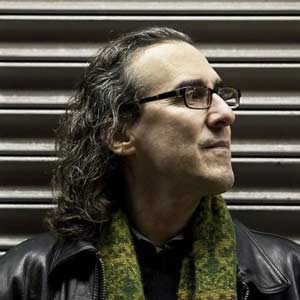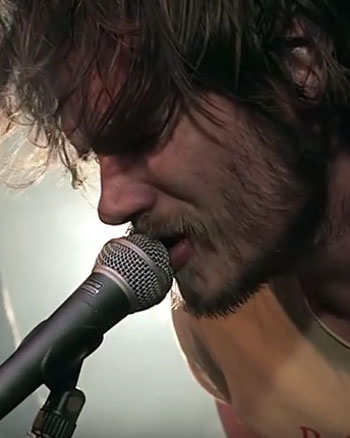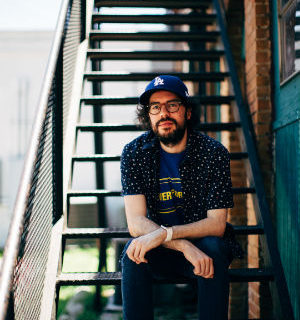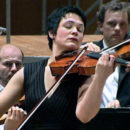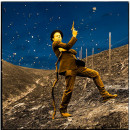Most listeners had no clue that the songs characters—Holly the transvestite, Andy the blow-job queen, Little Joe the gay hustler, Sugar Plum Fairy the Harlem cruiser, Jackie the speed freak—were actual people.
Will Hermes in Love Goes To Buildings On Fire.
Will Hermes looked down at his outfit, which consisted of dark boots, pants the color of coal, and a long scarf coiled around his neck that seemed to absorb light. “When you’re talking about Lou Reed, dressing in black seems appropriate,” the writer said.
Hermes and I met at Northshire Bookstore in Saratoga Springs, New York for a Writers in Conversation event sponsored by the Yaddo artist’s colony. For the past 90 years Yaddo has hosted residencies for everyone from Truman Capote and Sylvia Plath, to Delmore Schwartz and Laurie Anderson, both of whom had ties to Lou Reed. According to Hermes, Anderson was “Lou’s third wife and soulmate,” and “Delmore Schwartz was Lou’s writing mentor at Syracuse University. He was an incredibly talented poet and short story writer and a troubled guy near the end of his life when he taught at Syracuse. But, he’s the guy who Lou Reed credited with inspiring him to be a wordsmith and poet. I think Lou always identified himself––as much as he was a curator of sound and the electric guitar––[as] a poet, first and foremost.”
In 2011, Hermes published his debut book, Love Goes to Buildings on Fire: Five Years in New York That Changed Music, Forever. Over the past two years he’s been working on the quintessential Lou Reed biography, which will be published by Farrar, Straus and Giroux.
“There’s a huge amount of information,” he said of the new biography. “In some ways there’s too much information. It’s a matter of sifting through everything – and it’s not always reliable. A lot of people had an ax to grind, and some people who were close to him don’t know if they necessarily want to talk about him. Lou Reed also made up a whole lot of stories about things. Sometimes he is as much of an unreliable narrator about his life as anyone else. So, it’s been challenging.”
Hermes’ first book, which tweaks the name of the Talking Heads debut single, opens with a scene of the New York Dolls onstage at the Mercer Arts Center on New Year’s Eve 1972.
“At that particular time it was super cheap,” Hermes said. “A lot of the industry in Lower Manhattan fled to the suburbs. The city, because of a shortage of money, was laying off cops and sanitation workers so you had crime and you had garbage. When people fled, it left a lot of empty spaces for other people to come in,” says Hermes, who grew up in 1970s in Queens - the borough that spawned Johnny Thunders, The Ramones, The Shangri-Las, and the Coventry Club. Sometimes the worst situations produce the deepest beauty and the most profound change.
The city, because of a shortage of money, was laying off cops and sanitation workers so you had crime and you had garbage. When people fled, it left a lot of empty spaces for other people to come in.
“I remember sneaking in to see Television at CBGB. They were amazing. I got dressed up because I was 15 and I figured if I get dressed up, I’ll look older - which was not really the right approach to get into CBGB. They couldn’t care less. They were just like: ‘Five dollars.’ So I got in and saw Television. I couldn’t believe how long Tom Verlaine’s fingers were.”
Forty years later, Hermes is thinking ahead as much as he’s looking back. “This tradition of what was happening then is reverberating through what artists are doing now, and there is also a renewed appreciation for a lot of these artists,” said Hermes, who is a senior critic for Rolling Stone. “Some, like Patti Smith, have had a sort of renaissance. When I started researching the first book––which came out of the 30th anniversary of the album Horses––she hadn’t yet written Just Kids. It was pretty easy to call up her people and have her meet me in one of the coffee shops that she writes about in her new book M Train. I’d sit and we’d chat. Now, it’s hard to track her down.”
Reed’s lasting legacy is a body of work peppered with street prose, doo-wop inspirations, and noisy guitars that influenced a generation of musicians in a half-century of recorded works.
“Lou Reed was a complicated guy,” Hermes said. “He created incredibly great art and he created some art that was not so great. He’s also a guy who tended to make stuff that wasn’t appreciated in its time. The Velvet Underground made four albums that are considered among the greatest pop, rock, whatever-you-want-to-call-them-records in the past hundred years. It’s great art by any measure. But they couldn’t get arrested in a record store. Radio wouldn’t play any of that music.”
“Lulu, the last album that Lou Reed made––the collaboration with Metallica––there were reviews that basically said it was horrible. Heavy metal fans hated it. Lou Reed fans hated it. Everybody hated it. And Metal Machine Music was looked at like a joke. Was it? I don’t know,” Hermes said. “Now there’s an entire genre of music, noise music, that looks at that like a touchstone and is actually tied in to some of what Lamonte Young was doing. And I would say that Berlin being trounced was one of the greatest tragedies, one of the harshest experiences of his life. I think that was incredibly painful for him because he felt that was a really great work of art,” Hermes said. “And even there, he was vindicated.”
Reed died in 2013 at the age of 71.
Will Hermes writes for Rolling Stone and The New York Times, is a regular contributor to National Public Radio's "All Things Considered," and is the author of Love Goes To Buildings On Fire: Five Years in New York That Changed Music Forever. The tentative title of Hermes’ biography is Lou: A New York Life. A release date has yet to be finalized.


